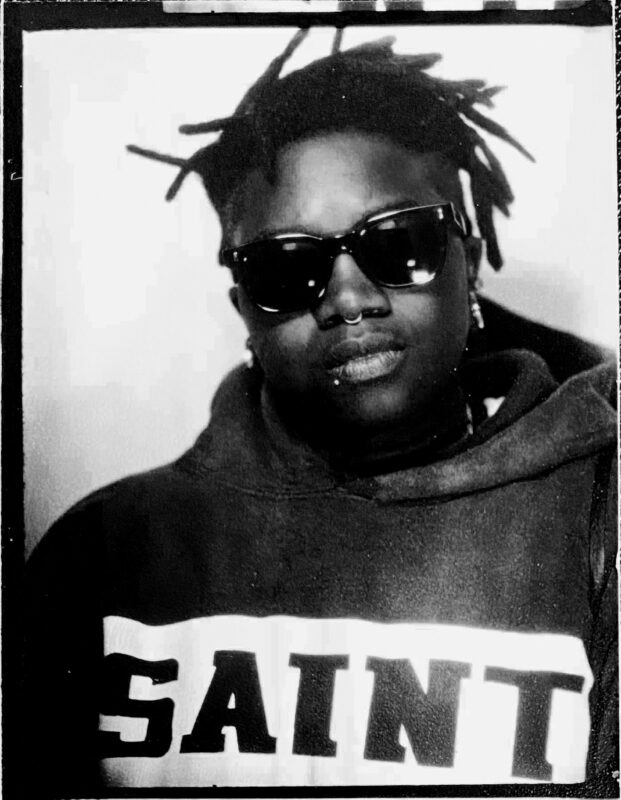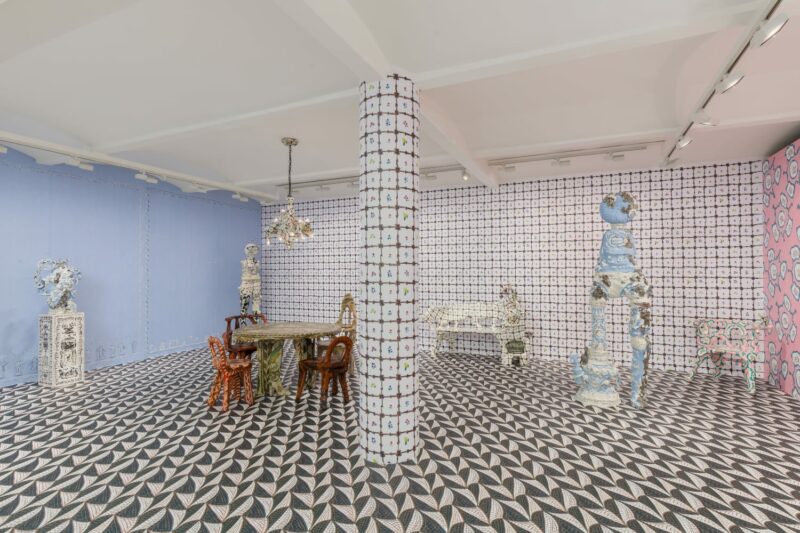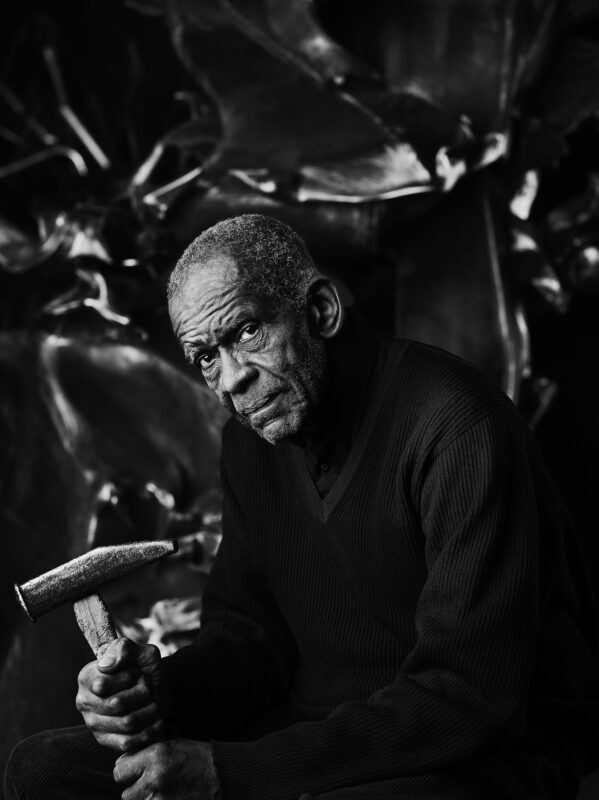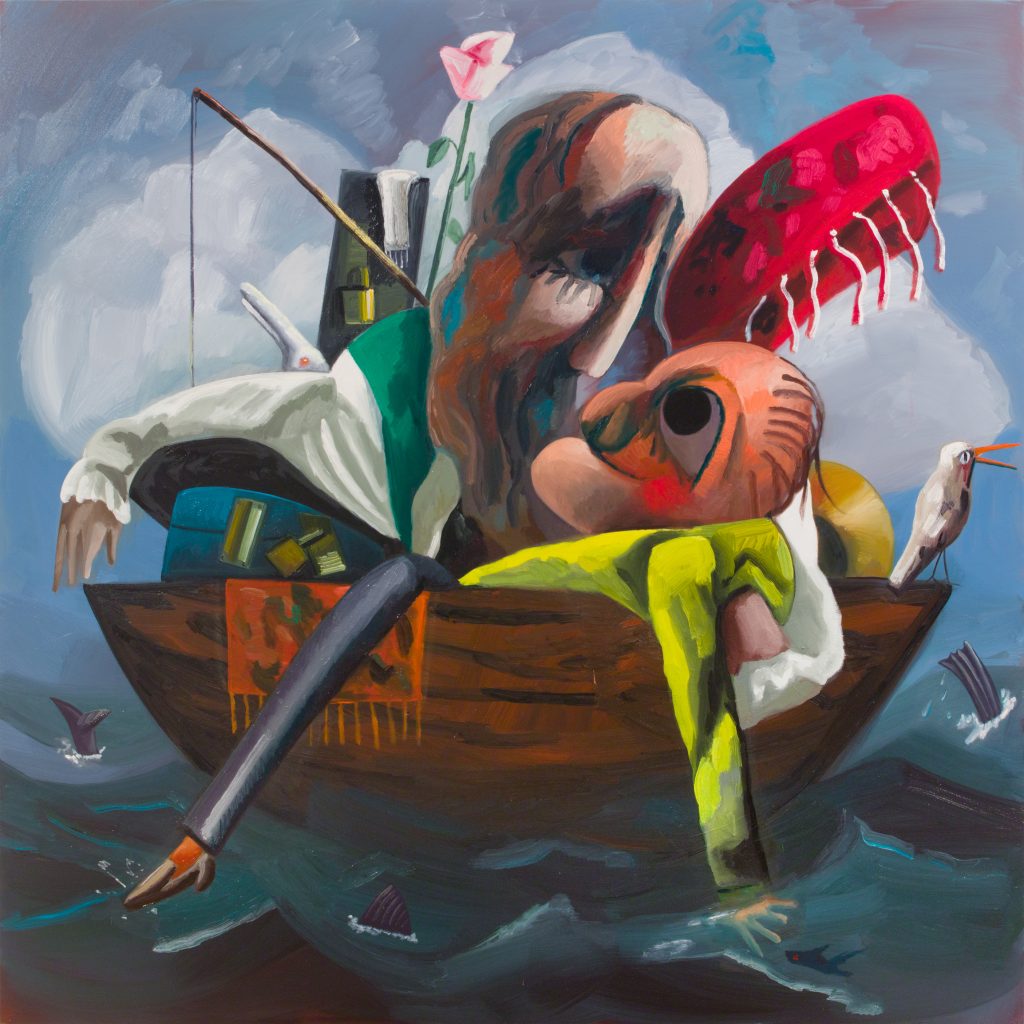
Dana Schutz Imagine You and Me 2018 Oil on canvas 223.5 x 223.5 cm ScH 18/016 © Dana Schutz. Courtesy the artist, Petzel Gallery, NY and Thomas Dane Gallery
Radical Figures: Painting in the New Millennium brings together a new generation of artists who represent the body in radical ways to tell stories and explore vital social concerns. Presenting for the first time this new direction in painting, the exhibition features ten painters at the heart of this zeitgeist: Michael Armitage, Cecily Brown, Nicole Eisenman, Sanya Kantarovsky, Tala Madani, Ryan Mosley, Christina Quarles, Daniel Richter, Dana Schutz and Tschbalala Self.
Painting had its last big hurrah in the 1980s when the stock market boom fuelled the brash brushwork and swagger of Neo-Expressionism. Leading critics were quick to pronounce its death. Through 40 canvases created over the last two decades, Whitechapel Gallery’s spring 2020 exhibition surveys the renewed interest in expressive and experimental modes of figuration among painters who have come to prominence since 2000.
The artists explore contemporary subjects including gender and sexuality, society and politics, race and body image. Pushing the notion of what figurative painting can be, the bodies they depict may be fragmented, morphed, merged and remade but never completely cohesive. They may also be fluid and non-gendered; drawn from news stories; represented by animals; or simply formed from the paint itself.
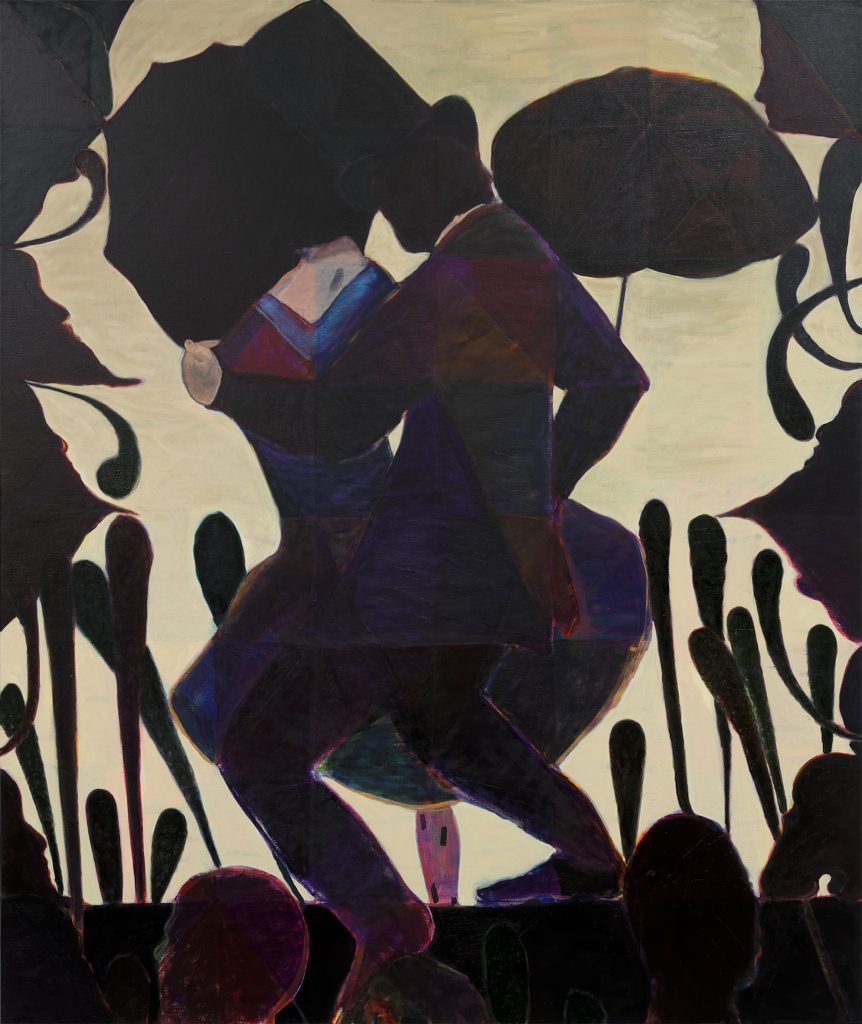
Ryan Mosley Cave Inn 2011 Oil on linen 214x180cm Private collection Courtesy of the artist, Galerie EIGEN+ART, Berlin / Leipzig and Tim Van Laere Gallery, Antwerp Photo: Dave Morgan
Embodying the painterly gesture to critique from within or broaden the lineage of a style long associated with canonical Eurocentric male painters, each artist references and creates work in dialogue with 19th and 20th-century painters including Victor Eugene Delacroix (1798–1863), Paul Gauguin (1848–1903), Willem de Kooning (1904–1997) and Maria Lassnig (1919–2014).
Lydia Yee, Chief Curator, Whitechapel Gallery says:
“By charting the return of an expressive mode of figuration, this exhibition asks broader questions about art and society today. These artists expand and destabilise fixed notions of identity through their depiction of indeterminate figures and partial bodies. By employing digital methods to create compositions; drawing subjects from online sources; or employing a flattened perspective reminiscent of a screen, they reflect new possibilities for the figure in an age when technology is transforming bodies and relationships. The narratives they explore encourage us to consider how painting can reflect personal anxieties and wider social concerns. Moreover, these artists are challenging and expanding the canonical Western painting tradition”
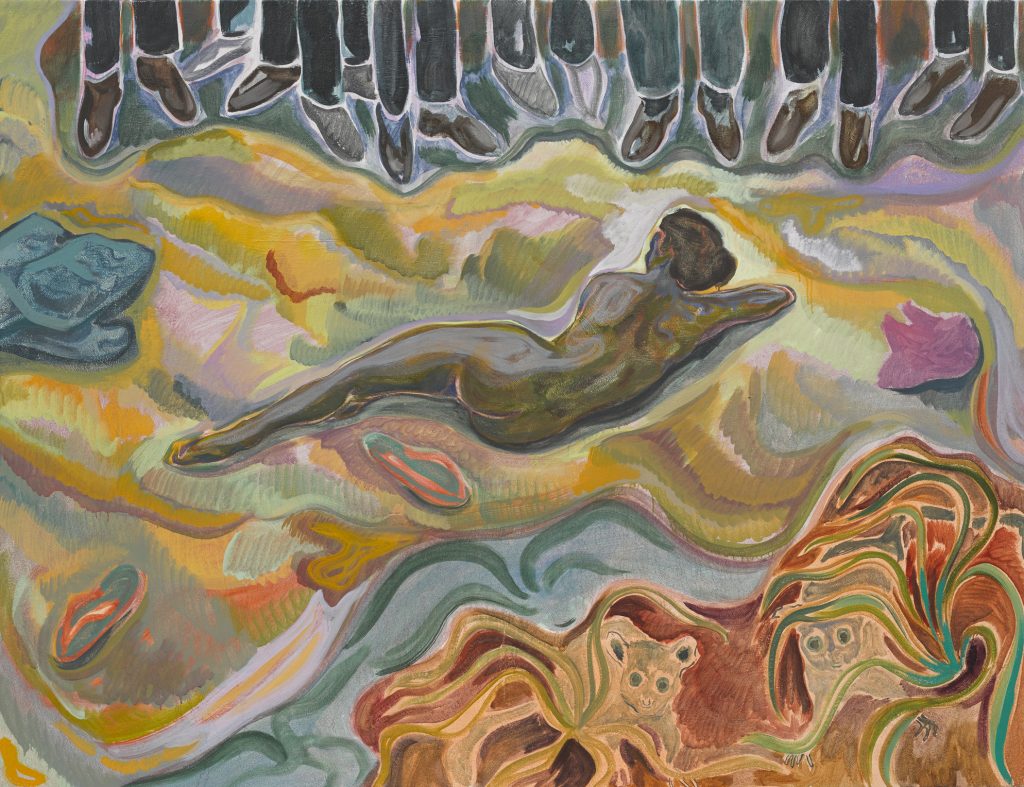
Michael Armitage #mydressmychoice 2015 Oil on Lubugo bark cloth 149.9 x 195.6 cm Private Collection, London © Michael Armitage. Photo © White Cube (George Darrell)
Works on display by Daniel Richter draw from recent events – the migrant crisis or Taliban mythology – as do Michael Armitage’s narratives of politics and violence in East Africa, equivocally conveyed in the lush, exoticised style of Gaugin. The rollicking surfaces of Cecily Brown’s canvases congeal into figures, whose sources range from pornography to art history, before dissolving back into atmosphere and paint. Studio scenes and the artist’s daily life are the subjects for Nicole Eisenman, while Dana Schutz imagines unlikely scenarios involving humanoid figures.
Tala Madani’s primal fantasies of abject men and children shift from comedy to debasement, from paint to shit. Sanya Kantarovsky and Ryan Mosely look to literature and children’s stories in their darkly humorous and carnivalesque scenes. In Christina Quarles’s canvases, groups of polymorphous nudes engage in sexual acts, merging with graphically patterned surfaces. Tschabalala Self pieces together paint, fabric and printed elements for a cast of characters inspired by the streets of Harlem.
Radical Figures: Painting in the New Millennium 6th February – 10th May 2020 Galleries 1, 8 & 9 @whitechapelgallery
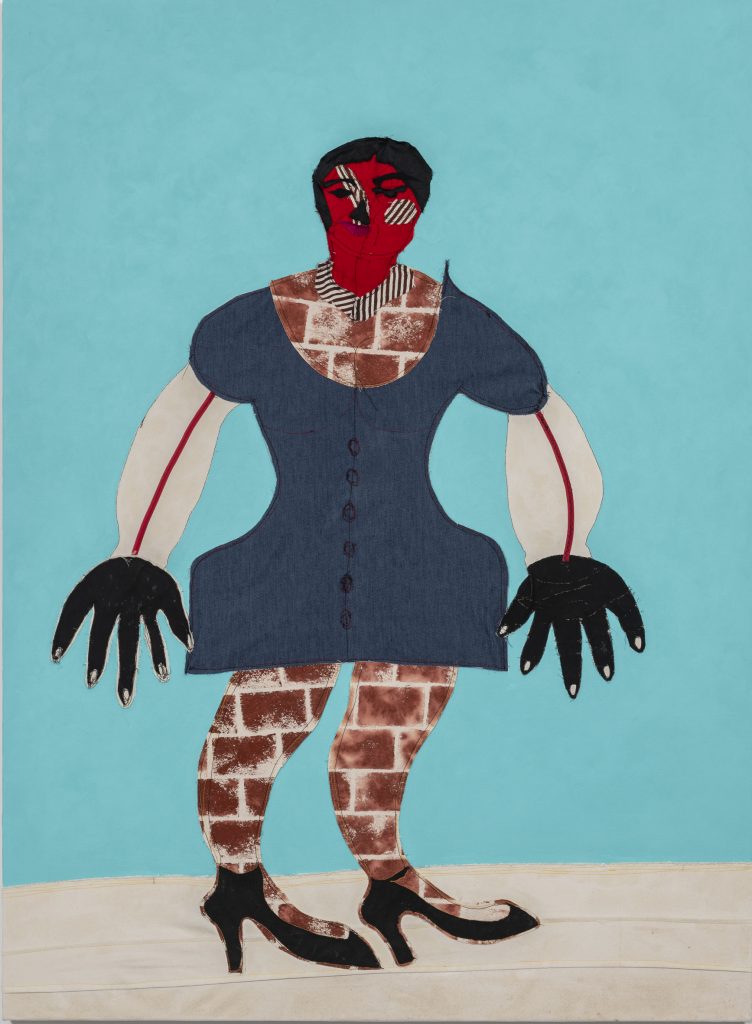
Tschabalala Self Lenox 2017 Fabric, ribbon, painted canvas, flashe and acrylic on canvas
172.7 x 127 cm Courtesy of the artist and Pilar Corrias Gallery
About the artists
Michael Armitage (b. 1984, Kenya) lives and works in London. He received his BA in Fine Art from the Slade School of Art, London (2007) and has a Postgraduate Diploma from the Royal Academy Schools, London (2010). His paintings have a dreamlike quality and his subjects are drawn from Kenyan and East African folklore, popular culture, online news and his own recollections. Armitage paints in oil on a traditional Ugandan bark cloth called Lubugo. Its course texture shows through the paint, which is meticulously layered. Recent solo exhibitions have been presented at the newly re-opened Museum of Modern Art,New York (2019) and South London Gallery (2018).
Cecily Brown (b. 1969, UK) lives and works in New York. She received a BA in Fine Art from the Slade School of Art, London (1993). In her large-scale paintings, figures engaged in lively physical activity are often indistinguishable within pastoral or bucolic settings. While inspired by the compositions of historic male painters such as Eugene Delacroix and the expressionist technique of Willem de Kooning, she presents a female-centred view of her subjects with sources ranging from pornography to High Renaissance painting. Recent solo exhibitions have been presented at the Louisiana Museum of Modern Art, Humlebæk, Denmark (2018) and Whitworth Art Gallery, Manchester (2017).
Nicole Eisenman (b. 1965, France) lives and works in New York. She received a BFA from Rhode Island School of Design, Providence (1987). Eisenman uses allegory and satire to engage not only with contemporary social subjects, from gender and sexuality to wealth and power but also the tropes of Western figurative painting traditions. Her cartoon-like figures explore human emotions or consider the role of the artist. Eisenman’s work in both painting and sculpture featured in the 2019 Venice Biennale and the 2019 Whitney Biennale in New York. In 2015 she was the recipient of a MacArthur Foundation fellowship.
Sanya Kantarovsky (b. 1982, Russia) lives and works in New York. He studied painting at the Rhode Island School of Design in Providence, RI (2004) and received his MFA at the University of California, Los Angeles (2011). His references include early 20th century European and Russian figurative artists Matisse, Gauguin and Chagall alongside children’s book illustrations and comic book imagery. His paintings depict lean and ungainly figures in darkly humorous, satirical or melancholic narratives often suggesting male humiliation and discomfort. Kantarovsky presented solo exhibitions at Kunsthalle Basel (2018) and Fondazione Sandretto Re Rebaudengo, Turin (2017–18).
Tala Madani (b. 1981, Iran) lives and works in Los Angeles. Madani received her MFA from Yale University School of Art (2006). Her psychologically charged works often include bald, middle-aged men engaged in crude, sexual or slapstick activities. In recent works, the body becomes a medium for exploring experiences around artistic identity and motherhood through a feminist lens. She combines tactile and expressive brushwork with more precise techniques derived from animation. In 2016 Madani presented a solo exhibition co-organised by MIT List Visual Art Centre and the Contemporary Art Museum St Louis, US and has a solo exhibition at Secession, Vienna (2019–20).
Ryan Mosley (b. 1980, UK) is based in Sheffield. He trained at the University of Huddersfield and Royal College of Art, London (2007). He assembles characters in performative narratives with a carnivalesque element. Motifs such as top hats, beards or foliage derived from sources as diverse as the paintings of René Magritte or the visual clichés of Hollywood Westerns give his paintings a timeless theatrical quality. Mosley’s work has featured in numerous institutional exhibitions including One Day, Something Happens: Paintings of People, Hayward Touring & Arts Council Collection exhibition, UK (2015) and Walls Have Ears, Aston Hall Museum, Birmingham, UK (2018).
Christina Quarles (b. 1985, USA) lives and works in Los Angeles. She received an MFA from the Yale School of Art in 2016, and holds a BA from Hampshire College. Her vibrantly coloured paintings feature entwined bodies in twisted or distended poses within abstracted environments and are often barely contained by the canvas. Quarles explores female, black and queer identity through the active agency of these bodies who demand direct engagement rather than passive consumption. Quarles has a solo exhibition at The Hepworth, Wakefield (2019-20) and was included in Made in LA at the Hammer Museum, Los Angeles (2018).
Daniel Richter (b. 1962, Eutin, Germany) lives and works between Berlin and Hamburg. He attended Hochschule für bildende Künste Hamburg (1991–96) and worked as an assistant to Albert Oehlen. Since the early 2000s he has produced large-scale oil paintings that bring together contemporary mass-media images with closely-observed figurative scenes. Shifting styles and subjects, he often creates work in dialogue with 19th and 20th century painters like James Ensor and Edvard Munch. Richter has held solo exhibition in museums worldwide, including at Camden Arts Centre, London (2017) and Schirn Kunsthalle, Frankfurt (2014–15).
Dana Schutz (b. 1976, USA) is based in New York. She received a BFA from the Cleveland Institute of Art (2000) and an MFA from Columbia University, New York (2002). Her paintings regularly feature grotesque single or grouped figures engaged in absurd, humorous and sometimes abject activities. Often working with thick impasto, Schutz describes her interest in painting as a medium in which the ‘hierarchies of the world can be rearranged’. Schutz has been the subject of several museum exhibitions including at the Institute of Contemporary Art, Boston (2017).
Tschabalala Self (b.1990 Harlem, USA) lives and works in New York and New Haven. She received an MFA from Yale School of Art in 2015. Self depicts female black figures in an exaggerated and bold style using a combination of sewn, printed, and painted textures. Her work aims to navigate the iconographic and sexualized representation of the Black female and male body in contemporary culture. Self held a solo exhibition at the Hammer Museum, Los Angeles (2019) and completed a residency at the Studio Museum, New York.
Categories
Tags
- Cecily Brown
- Christina Quarles
- Dana Schutz
- daniel richter
- Galerie EIGEN+ART
- Michael Armitage
- Neo-Expressionism
- Nicole Eisenman
- Petzel Gallery
- Radical Figures: Painting in the New Millennium
- Ryan Mosley
- Sanya Kantarovsky
- Tala Madani
- Thomas dane Gallery
- Tim Van Laere Gallery
- Tschbalala Self
- White Cube
- Whitechapel Art Gallery

